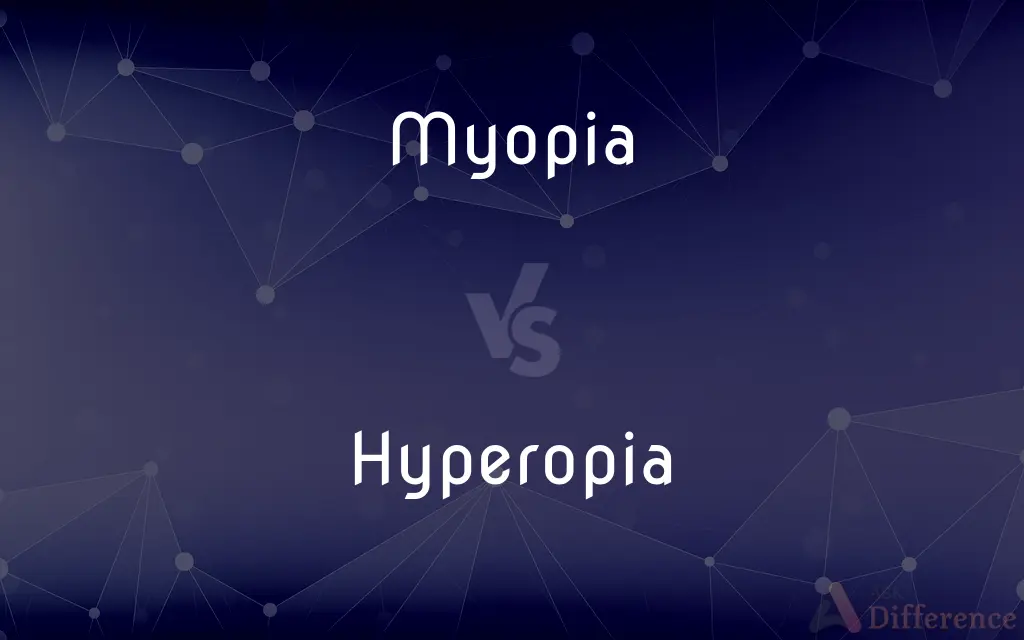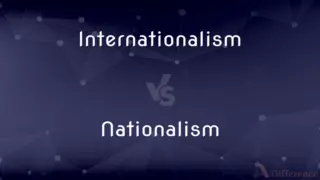Myopia vs. Hyperopia — What's the Difference?
Edited by Tayyaba Rehman — By Maham Liaqat — Updated on March 21, 2024
Myopia, or nearsightedness, causes difficulty seeing distant objects clearly, while hyperopia, or farsightedness, affects the ability to see close objects distinctly.

Difference Between Myopia and Hyperopia
Table of Contents
ADVERTISEMENT
Key Differences
Myopia is a vision condition where light entering the eye focuses in front of the retina, making distant objects appear blurry. This is often due to the eyeball being too long or the cornea having too much curvature. People with myopia can see objects that are close more clearly than objects that are far away. On the other hand, hyperopia occurs when light is focused behind the retina, often because the eyeball is too short or the cornea is too flat. This condition primarily affects the ability to see close objects clearly, while distant vision is usually better.
Individuals with myopia often struggle with tasks that require distant vision, such as driving or seeing a chalkboard from the back of a classroom. They may squint to see distant objects more clearly and experience eye strain or headaches from these efforts. Conversely, those with hyperopia may have difficulty with activities that involve close vision, like reading, sewing, or using a computer, which can also lead to eye strain and headaches.
The prevalence of myopia is increasing globally, attributed to factors like increased indoor activities and near work, such as using digital devices. Hyperopia's prevalence varies, but it's less influenced by lifestyle factors. Instead, it's often related to genetic factors and the natural aging process, which can affect the eye's ability to focus on close objects over time.
Both conditions are refractive errors that alter how light is focused by the eye but in opposite ways. Myopia is corrected with negative diopter lenses, which spread out light rays, whereas hyperopia is corrected with positive diopter lenses, which converge light rays. This distinction is crucial for the proper correction of each condition, ensuring improved vision and quality of life for those affected.
Comparison Chart
Definition
Difficulty seeing distant objects clearly.
Difficulty seeing close objects clearly.
ADVERTISEMENT
Cause
Light focuses in front of the retina.
Light focuses behind the retina.
Common Symptoms
Blurry distance vision, squinting, headaches.
Strained close vision, eye strain, headaches.
Eye Shape
Elongated eyeball or too much corneal curvature.
Short eyeball or too flat cornea.
Correction Lenses
Concave (minus diopter) lenses.
Convex (plus diopter) lenses.
Diagnosis Age
Often in childhood, can progress with age.
Can be present at birth, often noticed later.
Compare with Definitions
Myopia
A condition causing distant objects to appear blurry.
She wears glasses for myopia to see the board in class clearly.
Hyperopia
A condition impairing close vision clarity.
She discovered her hyperopia when she struggled to read books up close.
Myopia
Can progress during childhood and adolescence.
His myopia worsened during his teenage years.
Hyperopia
Corrected with convex lenses.
His glasses use convex lenses to correct his hyperopia.
Myopia
Myopia results from an elongated eyeball shape.
His myopia is due to his longer-than-average eyeball.
Hyperopia
May not be noticeable in children due to eye accommodation.
Despite her hyperopia, she had no trouble with close vision as a child.
Myopia
Corrected with concave lenses.
Her contact lenses correct her myopia by diverging light rays.
Hyperopia
Caused by a shorter eyeball or flat cornea.
Her hyperopia is due to her eye's shorter axial length.
Myopia
Increasing in prevalence due to lifestyle factors.
Increased screen time has been linked to rising myopia rates among children.
Hyperopia
Often becomes more apparent with age.
His hyperopia became more noticeable as he entered his forties.
Myopia
A visual defect in which distant objects appear blurred because their images are focused in front of the retina rather than on it. Also called nearsightedness, short sight.
Hyperopia
An abnormal condition of the eye in which vision is better for distant objects than for near objects. It results from the eyeball being too short from front to back, causing images to be focused behind the retina. Also called farsightedness, hypermetropia.
Myopia
Lack of discernment or long-range perspective in thinking or planning
"For Lorca, New York is a symbol of spiritual myopia" (Edwin Honig).
Hyperopia
(pathology) A disorder of the vision where the eye focusses images behind the retina instead of on it, so that distant objects can be seen better than near objects.
Myopia
(pathology) A disorder of the vision where distant objects appear blurred because the eye focuses their images in front of the retina instead of on it.
Hyperopia
An abnormal condition of the eye in which, through shortness of the eyeball or fault of the refractive media, the rays of light come to a focus behind the retina, making vision for distant objects better than for near objects; farsightedness; - called also hypermetropia. Cf. Emmetropia.
Myopia
(figurative) A lack of imagination, discernment or long-range perspective in thinking or planning.
Hyperopia
Abnormal condition in which vision for distant objects is better than for near objects
Myopia
Nearsightedness; shortsightedness; a condition of the eye in which the rays from distant object are brought to a focus before they reach the retina, and hence form an indistinct image; while the rays from very near objects are normally converged so as to produce a distinct image. It is corrected by the use of a concave lens.
Myopia
(ophthalmology) eyesight abnormality resulting from the eye's faulty refractive ability; distant objects appear blurred
Common Curiosities
What is myopia?
Myopia, or nearsightedness, is a condition where distant objects appear blurry because light focuses in front of the retina.
How are myopia and hyperopia corrected?
Myopia is corrected with concave lenses, while hyperopia is corrected with convex lenses.
How common are myopia and hyperopia?
The prevalence of myopia is increasing globally, especially among children and adolescents, while hyperopia's prevalence varies with age and genetic factors.
What is hyperopia?
Hyperopia, or farsightedness, is a vision condition where close objects are blurry due to light focusing behind the retina.
Why do people develop myopia or hyperopia?
Myopia is often due to an elongated eyeball or excessive corneal curvature, while hyperopia results from a shorter eyeball or too flat a cornea.
Does using glasses or contact lenses worsen myopia or hyperopia?
No, using the correct prescription lenses helps to correct vision and does not worsen the condition.
Can lifestyle factors affect myopia and hyperopia?
Lifestyle factors, particularly increased near work and less outdoor activity, are linked to myopia. Hyperopia is less influenced by lifestyle and more by genetics and aging.
Do myopia and hyperopia affect people of all ages?
Myopia is commonly diagnosed in childhood and can progress, while hyperopia can be present at birth but is often noticed later as the eye's ability to compensate decreases.
Can diet or vitamins prevent myopia or hyperopia?
There's no conclusive evidence that diet or vitamins can prevent these conditions, though a healthy lifestyle can support overall eye health.
Can myopia and hyperopia lead to other eye problems?
Yes, both conditions can increase the risk of other eye issues if not correctly managed, such as increased risk of retinal detachment for myopia and eye strain for hyperopia.
Is it possible to have both myopia and hyperopia?
It's rare for a person to have both conditions in the same eye, but it's possible to have myopia in one eye and hyperopia in the other, a condition known as anisometropia.
Can myopia and hyperopia be cured?
While there's no cure, both conditions can be effectively managed with corrective lenses or surgical options like LASIK.
How do I know if I have myopia or hyperopia?
Symptoms like blurry vision at distance (myopia) or close up (hyperopia), squinting, and eye strain warrant a professional eye examination for diagnosis.
Share Your Discovery

Previous Comparison
Internationalism vs. Nationalism
Next Comparison
Reel vs. JigAuthor Spotlight
Written by
Maham LiaqatEdited by
Tayyaba RehmanTayyaba Rehman is a distinguished writer, currently serving as a primary contributor to askdifference.com. As a researcher in semantics and etymology, Tayyaba's passion for the complexity of languages and their distinctions has found a perfect home on the platform. Tayyaba delves into the intricacies of language, distinguishing between commonly confused words and phrases, thereby providing clarity for readers worldwide.














































